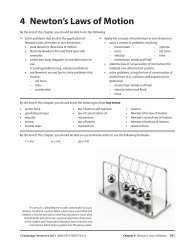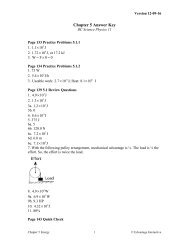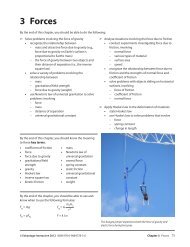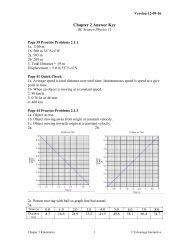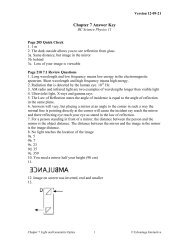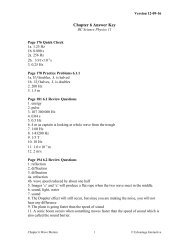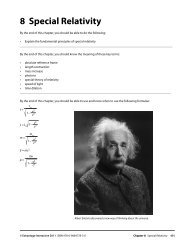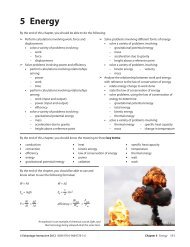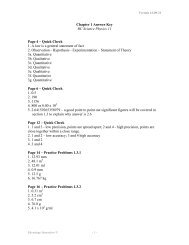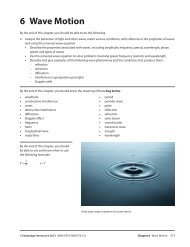2 Kinematics - BC Science Physics 11
2 Kinematics - BC Science Physics 11
2 Kinematics - BC Science Physics 11
You also want an ePaper? Increase the reach of your titles
YUMPU automatically turns print PDFs into web optimized ePapers that Google loves.
2.2 Acceleration<br />
Warm Up<br />
Below are two blank speed-time graphs.<br />
On graph (a), sketch the slope that represents a sports car traveling at constant speed.<br />
On graph (b), sketch the slope of the same car starting from rest and speeding up at a constant rate.<br />
�����<br />
���<br />
Changing Velocity<br />
��������������<br />
����<br />
48 Chapter 2 <strong>Kinematics</strong> © Edvantage Interactive 2012 ISBN 978-0-9864778-3-6<br />
�����<br />
���<br />
��������������<br />
����<br />
Whenever the velocity of an object changes, the object experiences acceleration.<br />
Acceleration is a change in velocity over a period of time:<br />
acceleration = change in velocity<br />
change in time<br />
The symbol for acceleration is a. Velocity has the same symbol as speed, which is v.<br />
If the velocity at the start of the time interval is v 0 , and at the end of the time interval is v f ,<br />
then the change in velocity will be v f – v 0 . If the time at the beginning of the time interval<br />
is t 0 , and the time at the end of the time interval is t f , then the change in time, the time<br />
interval, is t f – t 0 . Using these symbols, acceleration can be defined as:<br />
a = v f – v 0<br />
t f – t 0<br />
or a = ∆v<br />
∆t<br />
where the ∆ symbol is shorthand for “change in” or “interval.”<br />
Since velocity has two aspects to it, both speed and direction, acceleration can<br />
occur under three conditions:<br />
(a) if speed changes,<br />
(b) if direction changes or<br />
(c) if both speed and direction change.<br />
The standard unit for expressing acceleration is m/s 2 . An object is accelerating at a<br />
rate of 1 m/s 2 if its speed is increasing at a rate of 1 m/s each second.



